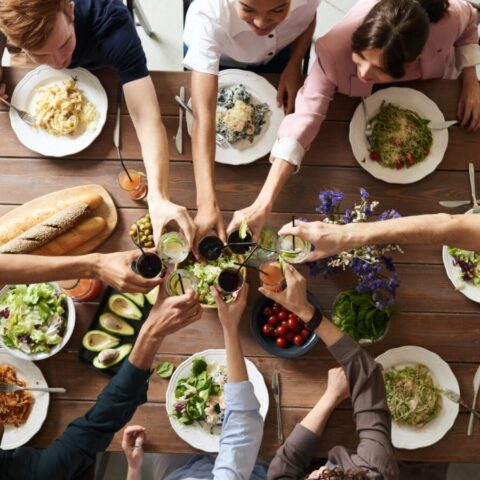Why The Paleo Diet Ignores the Ratios of Carbohydrates, Protein, and Fat

It’s remarkable how much current literature1-3 and popular diets focus on macronutrient ratios—the ratio of carbohydrate to fat to protein—from the “carbs are bad for you” Atkins diet to the 55-65% carbohydrate ratio of the popular food pyramid. It seems one of the hottest topics in nutrition today is the ideal ratio of carbohydrate to fat to protein.
But this debate can miss a very important point.
Throughout our entire evolution, our ancestors had no idea what carbohydrates, proteins, and fats were. I am certain that when offered a mango, no hunter-gatherer ever muttered the words “No thanks, I’m watching my carb intake.”
All they understood was what was edible and what was not.
The biography of Ishi—the last true North American hunter-gatherer—provides a great example of this awareness. After living most of his life as a hunter-gatherer, he was eventually forced to integrate into western society. While he was amazed by the quantity of foods now available to him, he refused to consume milk or butter. In his very limited English he explained that dairy “ruined his singing voice.”4 He knew nothing about the biochemistry of dairy. All he knew was that his body didn’t respond well to that particular food group.
This is, in my opinion, one of the greatest strengths of The Paleo Diet. While The Paleo Diet is lower than a Western diet in carbohydrates, it is not a low carb or a high protein/fat diet. That’s because not all carbohydrates, proteins, and fats are made the same.
A high-protein or high-carbohydrate diet can be healthy or unhealthy depending on the particular foods you eat. A high-carbohydrate diet based on fruits and vegetables can be healthy. A high-carbohydrate diet based on crackers and jelly beans is not.
What the Paleo Diet cares about is the particular foods you eat, not the ratios.
Eating the way you were designed to eat
I can’t emphasize this enough; the focus of The Paleo Diet is not on ratios, but on eating the foods we evolved to eat. The ratio is a byproduct.
In fact, we don’t have a defined macronutrient profile at all.
In their 2009 review of plant-animal subsistence ratios in hunter-gatherer societies, Dr. Cordain and his team were quick to point out that the plant-animal ratio varied greatly.5 Societies living close to the equator could get more than 55% of their calories from plant sources, while more polar societies (such as Inuit) derived almost all of their calories from animal sources.
As a result, the macronutrient ratios could be vastly different. Hunter-gatherer societies ate anywhere between 22-40% of their diet from carbohydrates, 19-35% from protein, and 28-58% from fat.
It is worth pointing out that despite the broad ranges, no society ate a diet as high in carbohydrates as the Western diet, which is often as high as 65% from carbohydrates.6 That goes back to the importance of the foods you eat. It is very difficult, if not impossible, to get 65% of your calories from carbohydrates without eating unhealthy processed foods.
Ironically, one of the most frequent criticisms of The Paleo Diet has been for its macronutrient ratio. That’s because in 2002, Dr. Cordain described a sample one-day Paleo menu in one of his early reviews. His sample menu was 23% carbohydrate, 38% protein, and 39% fat.7 Those numbers have been cited repeatedly by critics of the diet.
But again, they missed the point.
The point of the review was not to establish exact macronutrient ratios. Dr. Cordain could have easily laid out a sample Paleo menu that was higher or lower in carbohydrate to fat to protein. The point was to show that the sample menu consisted of nutrient-dense and healthier foods than a typical Western Diet.
Why generalizations are harmful: The carbohydrate/cancer link
It’s dangerous to make broad generalizations about macronutrients, including the common one about carbohydrates causing cancer.
Cancer has been increasingly associated with elevated levels of the hormone Insulin-Like Growth Factor 1 (IGF-1), a potent promoter of growth and cell division.8-11 As its name implies, IGF-1 shares many commonalities with insulin—including the fact that foods which spike insulin also increase IGF-1 and lower its inhibitor, Insulin-Like Growth Factor Binding Protein-3 (IGFBP-3).12, 13
If the foods that increase insulin also increase IGF-1, and it’s common knowledge that eating high-carbohydrate foods spikes insulin, it’s easy to draw the conclusion that carbohydrates promote cancer.14 But here’s the problem with that. Remember, fruits and vegetables are high-carbohydrate foods. So are we suggesting that vegetables promote cancer?
That would be a mistake. Fruits and vegetables have certainly been shown to be protective against cancer.15 A better way to determine how diet may influence both insulin and IGF-1 is to look at the glycemic load—a measure of the ability of individual foods to raise blood sugar levels.16, 17 High glycemic load foods have been linked to cancer in many studies.18-21
When we look at the glycemic load of individual foods instead of carbohydrates in general, we see a very different picture. As you might expect, the fruits and vegetables promoted by The Paleo Diet all have a low glycemic load despite being composed mostly of carbohydrates.16
Likewise, foods on the Paleo-no fly list such as refined grains and soft drinks have a very high glycemic load and may promote both IGF-122 and cancer.18-21 Interestingly, milk also has a low glycemic load value but still strongly raises insulin and IGF-1.23
The bottom line
There are still many great discussions to have about how to follow the modern-day Paleo Diet. For example, since most Paleolithic foods don’t exist in the same form anymore, how do we best approximate them? Another interesting question is whether we should modify our diet depending on where our individual ancestors came from.
These are great topics to explore, but remember that these questions are the minutia, not the focus. The foundation is to eat natural healthy foods, avoid processed foods that are known to be bad for us, and let the carb-protein-fat ratio be whatever it’s going to be.
References
1. Nilsson, L.M., et al., Low-carbohydrate, high-protein diet score and risk of incident cancer; a prospective cohort study. Nutrition Journal, 2013. 12: p. 10.
2. Pan, A., et al., Red Meat Consumption and Mortality Results From 2 Prospective Cohort Studies. Archives of Internal Medicine, 2012. 172(7): p. 555-563.
3. Zhou, J. and H. Xu, LOW CARBOHYDRATE AND HIGH PROTEIN DIETS AND ALL-CAUSE, CANCER AND CARDIOVASCULAR DISEASES MORTALITIES: A SYSTEMATIC REVIEW AND META-ANALYSIS FROM 7 COHORT STUDIES. Acta Endocrinologica-Bucharest, 2014. 10(2): p. 259-266.
4. Kroeber, T., Ishi in two worlds; a biography of the last wild Indian in North America. 1961, Berkeley,: University of California Press. 255 p.
5. Cordain, L., et al., Plant-animal subsistence ratios and macronutrient energy estimations in worldwide hunter-gatherer diets. Am J Clin Nutr, 2000. 71(3): p. 682-92.
6. McDowell, M.A., et al., Energy and macronutrient intakes of persons ages 2 months and over in the United States: Third National Health and Nutrition Examination Survey, Phase 1, 1988-91. Adv Data, 1994(255): p. 1-24.
7. Cordain, L., The nutritional characteristics of a contemporary diet based upon Paleolithic food groups. Journal of the American Nutraceutical Association, 2002. 5(5): p. 15-24.
8. Safarinejad, M.R., N. Shafiei, and S. Safarinejad, Relationship of insulin-like growth factor (IGF) binding protein-3 (IGFBP-3) gene polymorphism with the susceptibility to development of prostate cancer and influence on serum levels of IGF-I, and IGFBP-3. Growth Hormone & Igf Research, 2011. 21(3): p. 146-154.
9. Yu, H. and T. Rohan, Role of the insulin-like growth factor family in cancer development and progression. Journal of the National Cancer Institute, 2000. 92(18): p. 1472-1489.
10. Christopoulos, P.F., P. Msaouel, and M. Koutsilieris, The role of the insulin-like growth factor-1 system in breast cancer. Mol Cancer, 2015. 14(1): p. 43.
11. Zhu, S., et al., Insulin-like growth factor binding protein-related protein 1 and cancer. Clin Chim Acta, 2014. 431: p. 23-32.
12. Cordain, L., The Paleo diet : lose weight and get healthy by eating the foods you were designed to eat. Rev. ed. 2011, Hoboken, N.J.: Wiley. xv, 266 p.
13. Attia, N., et al., The metabolic syndrome and insulin-like growth factor I regulation in adolescent obesity. Journal of Clinical Endocrinology & Metabolism, 1998. 83(5): p. 1467-1471.
14. Freedland, S.J., et al., Carbohydrate restriction, prostate cancer growth, and the insulin-like growth factor axis. Prostate, 2008. 68(1): p. 11-9.
15. Block, G., B. Patterson, and A. Subar, FRUIT, VEGETABLES, AND CANCER PREVENTION – A REVIEW OF THE EPIDEMIOLOGIC EVIDENCE. Nutrition and Cancer-an International Journal, 1992. 18(1): p. 1-29.
16. Runchey, S.S., et al., Glycemic load effect on fasting and post-prandial serum glucose, insulin, IGF-1 and IGFBP-3 in a randomized, controlled feeding study. Eur J Clin Nutr, 2012. 66(10): p. 1146-52.
17. Foster-Powell, K., S.H. Holt, and J.C. Brand-Miller, International table of glycemic index and glycemic load values: 2002. Am J Clin Nutr, 2002. 76(1): p. 5-56.
18. Augustin, L.S., et al., Dietary glycemic index and glycemic load, and breast cancer risk: a case-control study. Ann Oncol, 2001. 12(11): p. 1533-8.
19. Woo, H.D., et al., Glycemic index and glycemic load dietary patterns and the associated risk of breast cancer: a case-control study. Asian Pac J Cancer Prev, 2013. 14(9): p. 5193-8.
20. Sieri, S., et al., Dietary glycemic index and glycemic load and risk of colorectal cancer: results from the EPIC-Italy study. Int J Cancer, 2014.
21. Eslamian, G., et al., Higher glycemic index and glycemic load diet is associated with increased risk of esophageal squamous cell carcinoma: a case-control study. Nutr Res, 2013. 33(9): p. 719-25.
22. Salmeron, J., et al., Dietary fiber, glycemic load, and risk of non-insulin-dependent diabetes mellitus in women. JAMA, 1997. 277(6): p. 472-7.
23. Hoyt, G., M.S. Hickey, and L. Cordain, Dissociation of the glycaemic and insulinaemic responses to whole and skimmed milk. Br J Nutr, 2005. 93(2): p. 175-7.




